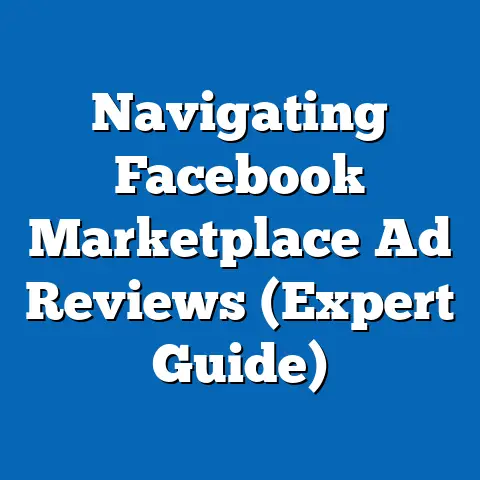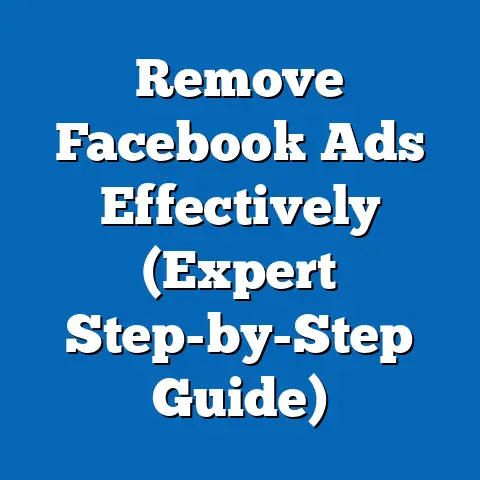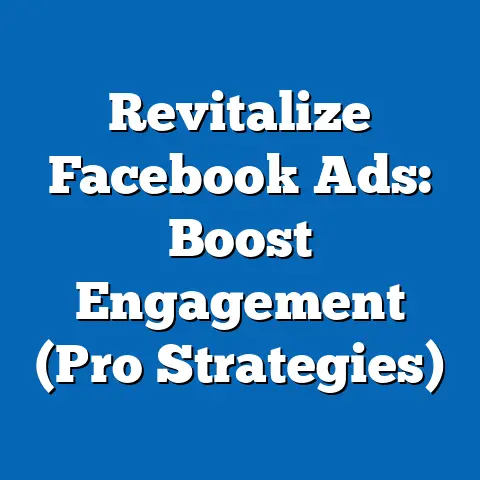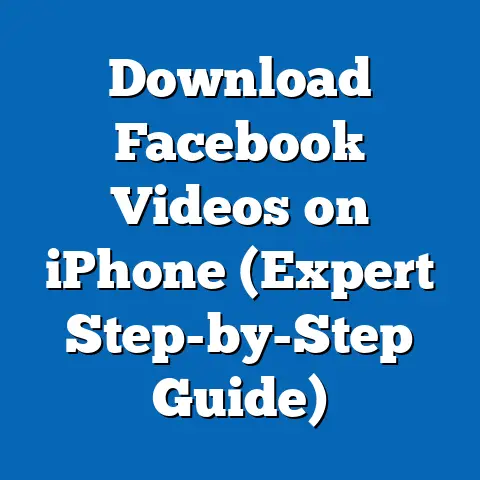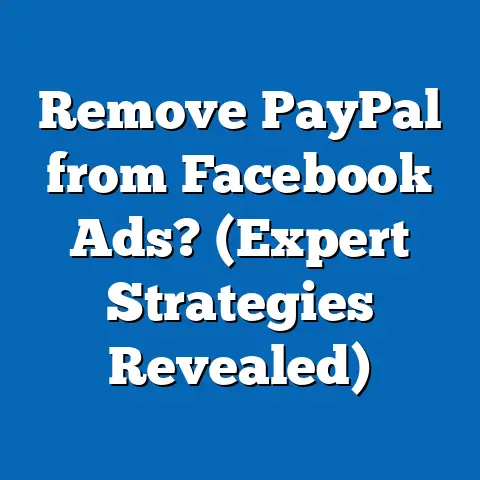Master Facebook Ad Processing (Unlock Hidden Strategies)
I’ve always believed in the power of digital marketing, especially when it comes to Facebook advertising. It’s not just about selling products; it’s about crafting a lifestyle where you have the freedom to pursue your passions, spend time with loved ones, and work from anywhere. I’ve seen countless individuals and businesses transform their lives by mastering Facebook ads, and I’m excited to share my insights and experiences with you.
This guide is designed to take you from a beginner to a Facebook ads master, equipping you with the knowledge and strategies you need to achieve remarkable results. Whether you dream of financial independence, more time for family, or the ability to travel the world, Facebook advertising can be your vehicle to a lifestyle upgrade.
Section 1: Understanding the Facebook Advertising Landscape
Before diving into the specifics, let’s get a clear picture of what Facebook advertising is all about.
Overview of Facebook Ads
Facebook ads are paid messages that businesses and individuals create to reach a specific audience on the Facebook platform, including Instagram and the Audience Network. Unlike organic content, which is shown to users based on algorithms and their existing network, ads are strategically placed to target users who fit specific criteria, regardless of whether they already follow your page or know about your business.
Think of it as having a megaphone that broadcasts your message to exactly the people who are most likely to be interested in what you have to offer.
The Importance of Facebook Ads
Why Facebook? The answer is simple: reach and engagement. Facebook boasts billions of active users, offering unparalleled opportunities to connect with potential customers across a vast demographic range. What sets Facebook apart is its incredibly granular targeting options. I’m talking about the ability to reach people based on their age, location, interests, behaviors, education, job titles, and even life events.
Moreover, Facebook provides a robust suite of tools for tracking and analyzing ad performance, allowing you to continuously optimize your campaigns for maximum impact. The platform is constantly evolving, introducing new features and ad formats that keep things fresh and exciting.
Key Statistics
Let’s look at some numbers to illustrate the power of Facebook advertising:
- Reach: Facebook has nearly 3 billion monthly active users, making it the most widely used social media platform globally. (Source: Statista)
- Ad Revenue: Facebook’s advertising revenue continues to grow, demonstrating the platform’s effectiveness for businesses.
- Engagement: Users spend an average of nearly 20 minutes per day on Facebook, presenting ample opportunities for ad exposure. (Source: Hootsuite)
- ROI: Businesses report an average ROI of \$9.70 for every \$1 spent on Facebook ads. (Source: HubSpot)
These statistics underscore the immense potential of Facebook advertising. With the right strategies, you can tap into this vast market and achieve significant results for your business.
Takeaway: Facebook advertising is a powerful tool for reaching a massive and diverse audience. Understanding its potential and key statistics is the first step towards unlocking your dream lifestyle.
Section 2: Setting Up for Success
Laying a solid foundation is crucial before launching any Facebook ad campaign. This section will guide you through the essential setup steps.
Defining Goals and Objectives
Before you spend a single dollar on ads, it’s imperative to define your goals and objectives. What do you want to achieve with your Facebook advertising? Are you looking to:
- Increase brand awareness?
- Generate leads?
- Drive sales?
- Promote an event?
- Increase app installs?
Your goals will dictate your entire advertising strategy, from targeting to ad creatives and budget allocation. Be specific and measurable. For example, instead of saying “increase brand awareness,” aim for “increase brand awareness by 20% among women aged 25-34 in the next three months.”
Creating a Business Account
To run Facebook ads, you need a Facebook Business Manager account. This is a separate platform from your personal Facebook profile that allows you to manage your business pages, ad accounts, and team members in one centralized location.
Here’s a step-by-step guide to creating a Business Manager account:
- Go to business.facebook.com.
- Click “Create Account.”
- Enter your business name, your name, and your business email address.
- Follow the prompts to set up your account.
- Add your Facebook page and/or create a new one.
- Add your ad account or create a new one.
Having a Business Manager account is crucial for maintaining a professional presence and managing your advertising efforts effectively.
Understanding the Facebook Pixel
The Facebook Pixel is a small snippet of code that you place on your website. It tracks user behavior, such as page views, add-to-carts, and purchases, and sends this data back to Facebook. This data allows you to:
- Track conversions: See how many people who click on your ads take desired actions on your website.
- Optimize ads: Improve your ad targeting and delivery based on real-time data.
- Retarget audiences: Show ads to people who have previously visited your website.
- Create Lookalike Audiences: Find new customers who are similar to your existing customers.
Installing the Facebook Pixel is essential for maximizing the effectiveness of your advertising campaigns. It provides valuable insights into user behavior and allows you to make data-driven decisions.
Takeaway: Setting up a Business Manager account and installing the Facebook Pixel are critical steps for launching successful Facebook ad campaigns. Defining clear goals will guide your overall strategy.
Section 3: Crafting Compelling Ad Content
Now that you have your foundation in place, let’s talk about creating ads that grab attention and drive results.
The Art of Ad Copywriting
Ad copywriting is the art of writing persuasive text that motivates people to take action. Here are some techniques to master this art:
- Know your audience: Understand their needs, pain points, and desires.
- Highlight benefits: Focus on how your product or service will improve their lives.
- Use strong calls to action: Tell them exactly what you want them to do (e.g., “Shop Now,” “Learn More,” “Sign Up”).
- Create a sense of urgency: Encourage them to act now (e.g., “Limited Time Offer,” “Sale Ends Soon”).
- Use emotional triggers: Tap into their emotions to create a connection (e.g., fear of missing out, desire for belonging).
For example, instead of writing “Our product is great,” write “Unlock your dream body with our revolutionary weight loss program. Limited spots available, sign up now!”
Visual Elements
Visuals are the first thing people see when they encounter your ad. High-quality images and videos are crucial for capturing attention and conveying your message effectively.
- Use professional photos and videos: Invest in high-quality visuals that showcase your product or service in the best light.
- Choose eye-catching designs: Use bright colors, bold fonts, and engaging graphics to stand out from the crowd.
- Optimize for mobile: Most Facebook users access the platform on their mobile devices, so make sure your visuals are optimized for small screens.
A/B Testing
A/B testing, also known as split testing, is the process of comparing two versions of an ad to see which one performs better. This involves creating two identical ads with one variable changed (e.g., headline, image, call to action) and running them simultaneously.
By tracking the performance of each ad, you can identify the winning variation and use it to optimize your campaigns. A/B testing is an ongoing process that helps you continuously improve your ad performance.
Takeaway: Compelling ad content is essential for attracting attention and driving results. Focus on writing persuasive copy, using high-quality visuals, and A/B testing your ads to optimize performance.
Section 4: Targeting Your Audience Effectively
Reaching the right audience is critical for maximizing the effectiveness of your Facebook ad campaigns. Facebook offers a wide range of targeting options, allowing you to reach specific demographics, interests, and behaviors.
Demographic Targeting
Demographic targeting allows you to reach users based on their age, gender, location, education, job title, and other demographic characteristics. This is a great way to narrow down your audience and ensure that your ads are seen by the people who are most likely to be interested in your product or service.
For example, if you’re selling baby products, you can target parents with children under the age of one. If you’re promoting a local event, you can target people who live within a certain radius of the event location.
Custom Audiences
Custom Audiences allow you to target people who have already interacted with your business, either online or offline. You can create Custom Audiences from:
- Your website: Target people who have visited specific pages on your website.
- Your customer list: Upload a list of your existing customers and target them with ads.
- Your mobile app: Target people who have installed your mobile app.
- Offline activity: Target people who have interacted with your business in person.
Lookalike Audiences are a powerful extension of Custom Audiences. They allow you to find new customers who are similar to your existing customers. Facebook analyzes the characteristics of your Custom Audience and identifies other users who share those characteristics.
Behavioral Targeting
Behavioral targeting allows you to reach users based on their interests, hobbies, and activities. Facebook collects data on user behavior, such as the pages they like, the groups they join, and the ads they click on. You can use this data to target users who are interested in specific topics.
For example, if you’re selling fitness equipment, you can target people who are interested in fitness, health, and wellness. If you’re promoting a travel destination, you can target people who are interested in travel, adventure, and culture.
Takeaway: Effective targeting is crucial for maximizing the effectiveness of your Facebook ad campaigns. Use demographic, Custom, and behavioral targeting to reach the right audience and drive results.
Section 5: Budgeting and Bidding Strategies
How you allocate your budget and bid for ad placements can significantly impact the performance of your Facebook ad campaigns.
Understanding Ad Budgets
Facebook offers two main budgeting options:
- Daily budget: The average amount you’re willing to spend each day.
- Lifetime budget: The total amount you’re willing to spend over the entire duration of your campaign.
When choosing a budget, consider your goals, target audience, and the potential return on investment. Start with a smaller budget and gradually increase it as you see positive results.
Bidding Techniques
Facebook offers two main bidding options:
- Automatic bidding: Facebook automatically sets your bids to get the most results for your budget.
- Manual bidding: You set your bids manually, giving you more control over your ad costs.
Automatic bidding is a good option for beginners, while manual bidding is better suited for experienced advertisers who want more control over their campaigns.
ROI Measurement
Measuring the return on investment (ROI) of your Facebook ads is essential for determining whether your campaigns are profitable. ROI is calculated as:
(Revenue – Cost) / Cost
Track your ad spend and the revenue generated from your ads to calculate your ROI. This will help you determine which campaigns are working and which ones need to be optimized.
Takeaway: Smart budgeting and bidding strategies are essential for maximizing the ROI of your Facebook ad campaigns. Choose the right budget and bidding option based on your goals and experience level.
Section 6: Advanced Strategies for Facebook Ads Mastery
Once you’ve mastered the basics, it’s time to explore some advanced strategies that can take your Facebook advertising to the next level.
Retargeting Campaigns
Retargeting is the process of showing ads to people who have previously interacted with your business, either on your website, in your app, or on Facebook. Retargeting can significantly improve conversion rates by re-engaging users who have already shown interest in your product or service.
For example, you can retarget people who have visited your website but haven’t made a purchase, or people who have added items to their cart but haven’t completed the checkout process.
Utilizing Facebook Stories and Reels
Facebook Stories and Reels are short-form video formats that have become increasingly popular in recent years. They offer a great opportunity to reach a younger audience and create engaging, interactive content.
- Keep it short and sweet: Stories and Reels are designed for quick consumption, so keep your videos short and to the point.
- Use visually appealing content: Use high-quality videos and graphics that capture attention.
- Add interactive elements: Use polls, quizzes, and other interactive elements to engage your audience.
Leveraging User-Generated Content
User-generated content (UGC) is content created by your customers, such as reviews, testimonials, and photos or videos of them using your product or service. UGC can be a powerful tool for building trust and authenticity, leading to higher engagement and conversion rates.
Encourage your customers to create UGC by running contests, offering incentives, or simply asking them to share their experiences.
Takeaway: Advanced strategies like retargeting, utilizing Facebook Stories and Reels, and leveraging user-generated content can significantly improve the performance of your Facebook ad campaigns.
Section 7: Analyzing and Optimizing Campaign Performance
The journey doesn’t end when your ads go live. Continuous monitoring and optimization are essential for maximizing the effectiveness of your Facebook ad campaigns.
Using Facebook Ads Manager
Facebook Ads Manager is the central hub for managing your advertising campaigns. It provides a comprehensive overview of your campaign performance, allowing you to track key metrics, analyze data, and make data-driven decisions.
Familiarize yourself with the Ads Manager dashboard and learn how to navigate the various sections. This will allow you to monitor your campaigns effectively and make timely adjustments.
Key Metrics to Monitor
Here are some essential metrics to track:
- Click-Through Rate (CTR): The percentage of people who click on your ad after seeing it.
- Conversion Rate: The percentage of people who take desired actions after clicking on your ad (e.g., making a purchase, signing up for a newsletter).
- Cost Per Acquisition (CPA): The cost of acquiring a new customer through your ad campaign.
- Return on Ad Spend (ROAS): The revenue generated for every dollar spent on your ad campaign.
By monitoring these metrics, you can identify areas for improvement and optimize your campaigns for better results.
Continuous Improvement
Facebook advertising is an ongoing process. You should regularly review your ad performance, analyze data, and make data-driven decisions to optimize your campaigns for better results.
- Test different ad creatives: Experiment with different images, videos, and ad copy to see what resonates best with your audience.
- Refine your targeting: Continuously refine your targeting to reach the most relevant audience.
- Adjust your bidding strategy: Adjust your bidding strategy based on your campaign performance and goals.
Takeaway: Continuous monitoring and optimization are essential for maximizing the effectiveness of your Facebook ad campaigns. Use Facebook Ads Manager to track key metrics, analyze data, and make data-driven decisions.
Conclusion: Your Path to Facebook Ad Success
Mastering Facebook ad processing is not just about learning the techniques; it’s about embracing a mindset of continuous improvement and adaptation. The Facebook advertising landscape is constantly evolving, so it’s essential to stay up-to-date with the latest trends and best practices.
I encourage you to take actionable steps towards implementing the strategies discussed in this guide. Start by setting up your Business Manager account, installing the Facebook Pixel, and defining your advertising goals. Then, experiment with different ad creatives, targeting options, and bidding strategies.
Remember, success in Facebook advertising requires persistence, patience, and a willingness to learn. With the right knowledge and dedication, you can unlock the hidden potential of Facebook advertising and enjoy the lifestyle upgrade you desire. Your dream lifestyle is within reach, and Facebook advertising can be your vehicle to get there. Now go out there and make it happen!


